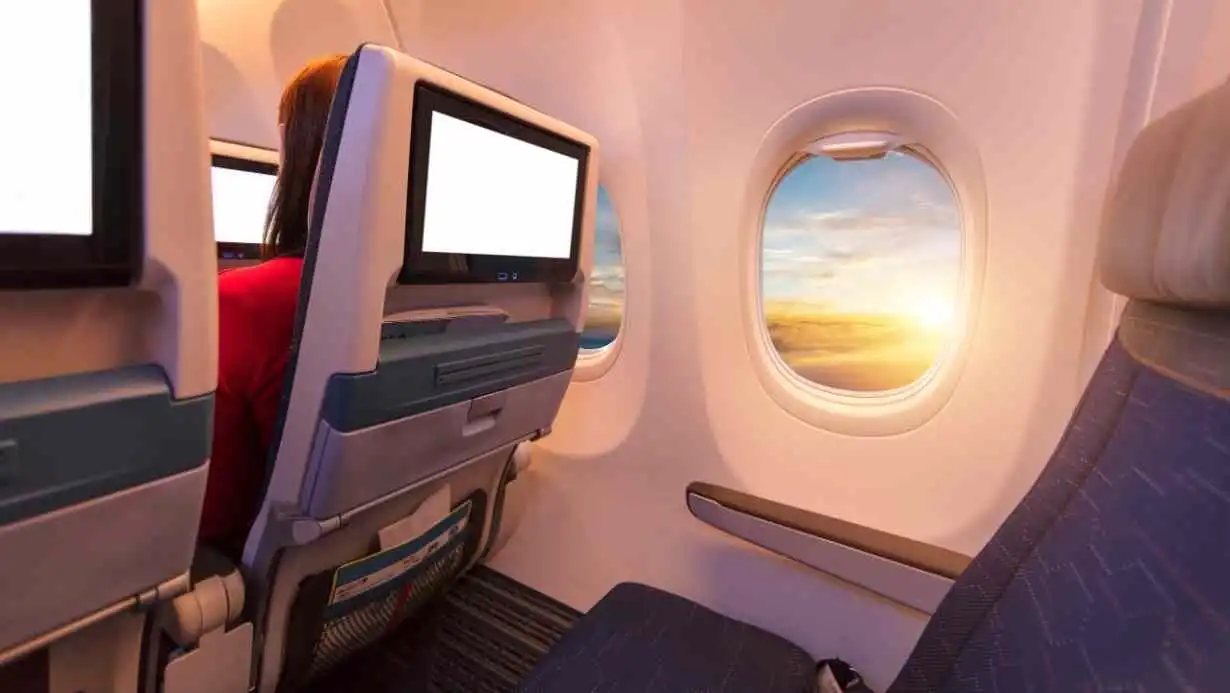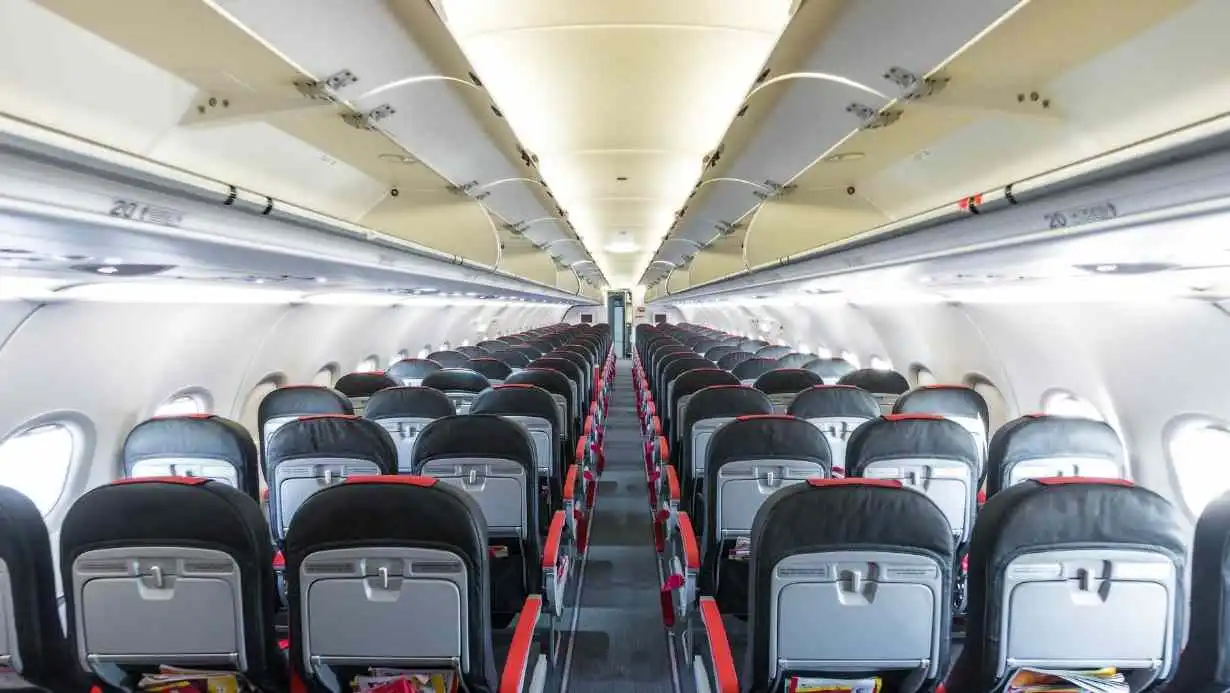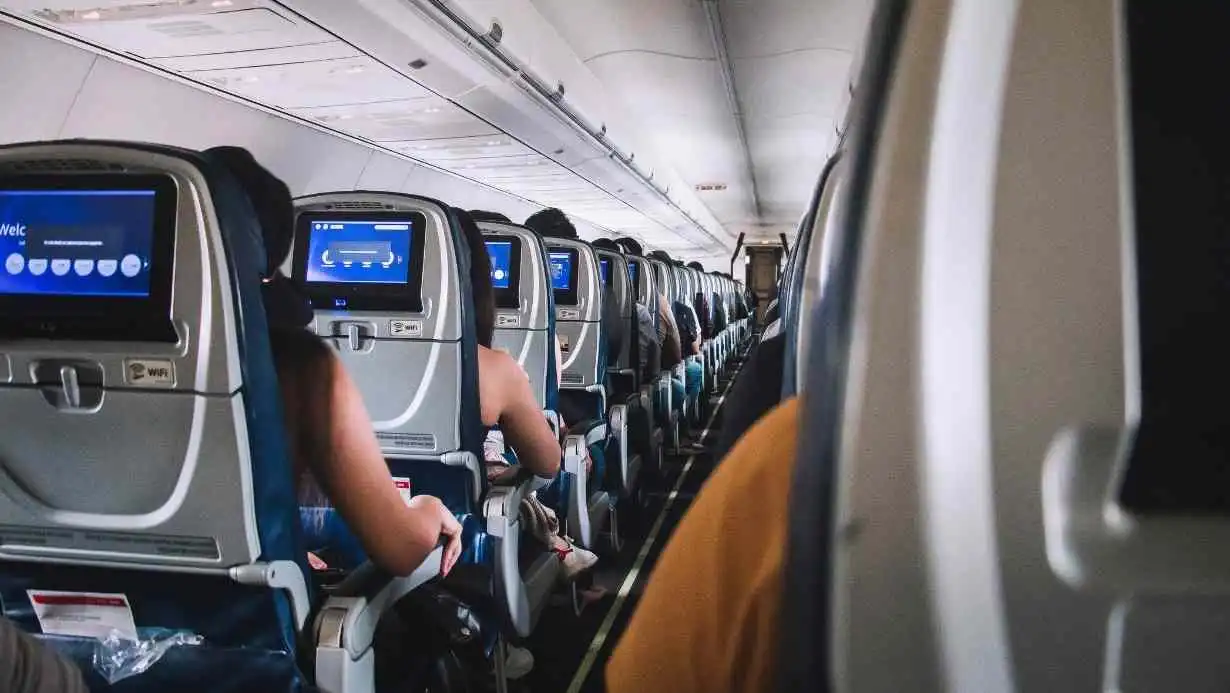Exit Row Airplane Seats: Everything about Pros, Cons and Restrictions
Are You Seeking Extra Legroom on Your Next Flight? Discover the Perfect Seating Options for Your Ultimate Comfort and Safety. If you’re planning your next air travel adventure and pondering the question, “Are there better seating choices to make my journey more comfortable?” – you’re in the right place.
Whether you’re flying for business or pleasure, your seating selection plays a pivotal role in ensuring your comfort and safety. With today’s focus on passenger well-being, airlines offer a range of seating options that cater to various preferences and requirements.
What is the Exit Row Airplane Seat?
The exit row seat is a sought-after seating option on airplanes and for a good reason. It is the row of seats that is typically located near the emergency exits of the aircraft. These seats offer a range of benefits that can significantly enhance your flying experience. Let’s take a closer look at what makes the exit row seat special:
The most notable feature of the exit row seat is the ample legroom it provides. If you’re someone who often feels cramped in the standard seats, the exit row seat might be your savior. With more space to stretch your legs, you’ll find that your journey becomes much more comfortable. Whether you’re on a short domestic flight or a long-haul international journey, having that extra legroom can make a world of difference.
The exit row seat is its proximity to the emergency exits. In the event of an evacuation, exit row passengers are in a prime position to make a quick and safe exit from the aircraft. This can be crucial in emergencies where every second counts. Airlines typically require exit row passengers to be physically capable of assisting in an evacuation, ensuring that everyone’s safety is a top priority.
The combination of extra legroom and quick exit access contributes to enhanced overall comfort during the flight. You can relax more easily, stretch out, and enjoy the journey. Whether you want to catch up on some sleep, read a book, or just sit back and watch a movie, the exit row seat provides a comfortable environment to do so.
Choosing the Right Exit Row Seat
Selecting the right exit row seat can greatly enhance your air travel experience. Not all exit row seats are identical, so it’s essential to consider your preferences and needs when making your choice. Here’s a guide on how to choose the perfect exit-row seat for your journey:
Location Matters: Exit row seats come in various configurations. Some are situated next to windows, some next to aisles, and others may be in the middle of the row. When choosing an exit row seat, consider whether you prefer a window view or easy access to the aisle. If you value the scenery and don’t mind climbing over a fellow passenger to reach the aisle, a window seat in the exit row might be your preference. On the other hand, if you prefer to move around the cabin without disturbing others, an aisle seat in the exit row is a practical choice.
Recline Options: The exit row seats, due to their proximity to the emergency exits, may have limited or no recline. Consider whether the ability to recline your seat is important to you. If you like to lean back during the flight, you might want to check if the exit row seat you’re eyeing offers any reclining options.
Row Configuration:Pay attention to the aircraft’s specific row configuration in relation to the exit row. Some planes may have multiple exit rows, each with slightly different features. Verify the row number and the seat’s position within the exit row to ensure it aligns with your preferences.
Group Travel: If you’re traveling with a group, coordinate your seating choices in advance. While exit row seats offer extra legroom and advantages, sitting together can be equally important for a pleasant journey.
Review Seat Maps: Before booking your flight, review the seat map of the aircraft. This will help you visualize the layout and see where the exit row seats are located. It’s also an opportunity to check if there are any potential obstructions or drawbacks specific to certain exit row seats.
Check with the Airline: Each airline may have slight variations in their exit row seat offerings. Contact the airline or visit their website to get more information about the specific features and requirements for exit row seats on your chosen flight. Some airlines may even allow you to reserve your preferred exit row seat during the booking process.
Choosing the right exit row seat involves considering factors such as seat location, recline options, row configuration, group travel, reviewing seat maps, and checking with the airline for more details. By carefully assessing your needs and preferences, you can ensure that the exit row seat you select enhances your in-flight experience and contributes to a comfortable and enjoyable journey.
Exit Row Airplane Seats: Pros
Exit row airplane seats are highly coveted for several compelling reasons, making them a popular choice among air travelers seeking a more comfortable and convenient flying experience. Here are some of the notable advantages of selecting exit row seats:
Extra Legroom: The most prominent and widely recognized benefit of exit row seats is the substantial extra legroom they offer. These seats are strategically positioned to provide passengers with significantly more space to stretch their legs. This is a boon for tall individuals or anyone who values the freedom to move and avoid the discomfort of cramped seating. The extra legroom can make long flights far more bearable, allowing you to sit with greater ease.
Quick Exit Access: Exit row seats are strategically located near the aircraft’s emergency exits. This proximity comes with the valuable advantage of quick exit access. In the rare event of an emergency evacuation, exit row passengers are the first in line to exit the plane, potentially making a significant difference in ensuring the safety of all passengers. Airlines have specific requirements for those seated in exit rows, emphasizing their role in assisting with evacuations and maintaining passenger safety.
Enhanced Comfort: The combination of extra legroom and the reassurance of being near an emergency exit contributes to an overall enhanced level of comfort during the flight. Passengers in exit row seats have more room to relax and enjoy their journey. Whether you wish to work, sleep, read, or enjoy in-flight entertainment, the exit row seat provides a more comfortable environment to do so.
Priority Services: Some airlines offer additional perks to passengers occupying exit row seats. These can include priority boarding, allowing you to get settled in your seat before other passengers, and expedited meal service. These extra services add a touch of luxury to your flight experience and can make the overall journey more enjoyable.
Suitable for Families: Exit row seats are often favored by families traveling with infants or small children. The extra space allows for a more comfortable and less restrictive journey for both parents and their little ones. This makes flying with children a less stressful experience.
Better Views: Depending on the aircraft’s layout, exit row seats, especially those next to the window, can offer spectacular views during the flight. If you enjoy gazing at the scenery below or the skies above, these seats are an excellent choice.
In summary, exit row airplane seats offer numerous advantages, including extra legroom, quick exit access, enhanced comfort, potential priority services, suitability for families, and the possibility of enjoying better views. If you’re looking to enhance your air travel experience and make your journey more comfortable, exit row seats are a compelling choice. However, it’s essential to note that these seats come with specific responsibilities and requirements, and not all exit row seats are identical, so be sure to meet the airline’s criteria if you wish to occupy one.
Exit Row Airplane Seats: Cons
Exit Row Airplane Seats: Cons
Exit row airplane seats come with several benefits, as we’ve discussed, but they also have their drawbacks. It’s important to consider both the pros and cons when deciding if an exit row seat is the right choice for your flight. Here are some of the potential disadvantages of exit row seats:
- Limited Recline:
One of the significant drawbacks of exit row seats is that they often have limited or no recline. This limitation is primarily due to safety regulations. Reclining seats could obstruct the emergency exit pathways, so they are typically fixed in an upright position. For passengers who enjoy reclining their seats to relax or sleep, this lack of recline can be a downside, especially on long flights.
- Potentially Colder Temperatures:
Exit row seats are often located near the emergency exits, and these areas can be cooler than the rest of the cabin. Passengers sitting in these seats may experience slightly lower temperatures, which can be uncomfortable, especially on long-haul or overnight flights. It’s advisable to bring an extra layer of clothing or a blanket to stay warm if you choose an exit row seat.
- Increased Noise and Disturbance:
Exit row seats are sometimes closer to the galley, lavatories, or emergency equipment. This proximity can result in more noise and disturbances during the flight. Passengers in these seats may experience higher foot traffic, noise from the crew, service carts, or the sound of flushing toilets. If you’re looking for a quieter and more peaceful journey, this aspect can be a downside.
- Responsibility During Emergencies:
Passengers seated in the exit row have specific responsibilities in the event of an emergency, and they are expected to assist the crew and fellow passengers. This responsibility can be a drawback for travelers who prefer a more relaxed and carefree flight. Being ready to follow instructions and stay calm in high-stress situations is essential when occupying an exit row seat.
- Age and Physical Condition Restrictions:
Airlines have age and physical condition restrictions for exit row seats. This means that not all passengers, including children and those with certain physical limitations, are eligible to occupy these seats. Families with young children or individuals who don’t meet the airline’s criteria may find their seating options limited.
- Unavailability on Some Aircraft:
Not all aircraft have exit row seating, and even when they do, the number of exit row seats can vary. This means that, depending on your flight and the type of aircraft, exit row seats may not be available for selection. Passengers who specifically seek out these seats may be disappointed if they are not available on their chosen flight.
While exit row airplane seats offer many advantages, they also come with some notable drawbacks. These include limited seat recline, potentially colder temperatures, increased noise and disturbances, responsibilities during emergencies, age and physical condition restrictions, and the unavailability of exit row seats on some aircraft. It’s essential for passengers to consider these cons alongside the pros when deciding whether exit row seats are the right choice for their individual needs and preferences.
Restrictions and Requirements
Exit row seats are highly sought after for their extra legroom and other benefits, but they also come with specific restrictions and requirements imposed by airlines to ensure the safety of passengers. Understanding these restrictions and requirements is essential before choosing an exit row seat. Here are the key aspects to consider:
- Age and Physical Condition:
Airlines have age and physical condition restrictions for passengers occupying exit row seats. These restrictions are in place to ensure that passengers seated in these rows are physically capable of assisting in the event of an emergency evacuation. While the specific criteria can vary between airlines, some common requirements include:
- Passengers must be at least 15 to 18 years of age, depending on the airline.
- Passengers must not have any mobility impairments or disabilities that could hinder their ability to operate the exit door or assist in an emergency.
- Passengers must be able to understand and communicate in the language of the flight attendants and safety instructions.
It’s crucial for passengers to honestly assess their age and physical condition to ensure they meet these requirements. Attempting to occupy an exit row seat when one does not meet these criteria could result in being reassigned to another seat.
- Responsibility:
Passengers seated in the exit row have a higher level of responsibility during the flight, especially in the event of an emergency. They are expected to assist the flight crew and fellow passengers in the event of an evacuation. This includes understanding and being willing to execute emergency procedures such as operating the exit door, helping others exit, and remaining calm under stressful conditions.
This responsibility extends to remaining seated during takeoff and landing and being prepared to help fellow passengers understand and follow the flight attendants’ instructions. Passengers who are not comfortable with these added responsibilities should consider alternative seating.
- Following Instructions:
One of the most critical requirements for passengers seated in the exit row is the ability to follow instructions from the flight crew. This is essential in both routine and emergency situations. Passengers must be prepared to listen to and carry out the instructions provided by the flight attendants, especially in high-stress scenarios.
Disobeying instructions or not being attentive to the crew’s guidance can compromise safety and hinder the overall operation of the aircraft. Therefore, passengers occupying exit row seats should be ready and willing to follow instructions without hesitation.
Exit Row Etiquette
When you’re fortunate enough to secure an exit row seat, it’s essential to be mindful of exit row etiquette to ensure a comfortable and safe flight for yourself and your fellow passengers. Here are some key points to keep in mind:
Occupying the Exit: If an emergency occurs, you will be responsible for operating the exit door. Be familiar with how it works and ensure it’s ready for use. In case you need to open it, follow the instructions provided by the flight crew.
Stay Seated During Takeoff and Landing: As per airline safety regulations, exit row passengers must remain seated during takeoff and landing. This ensures that they are ready and available to assist in an emergency situation.
Avoid Reclining Your Seat: Exit row seats typically do not recline to prevent obstructions in the emergency exit pathways. Respect this limitation and avoid attempting to recline your seat.
Be Courteous to Fellow Passengers: Although you have extra legroom, be mindful of how your movements may impact the passengers around you. Avoid blocking the aisles and respect the personal space of those seated near you.
Offer Assistance to Others: If you’re physically capable, be ready to assist passengers with disabilities or those who may need help during the flight. Your willingness to assist others is part of the exit row passenger’s responsibility.
Keep Personal Items Stowed: Ensure that your personal belongings are securely stowed during takeoff, landing, and in emergencies. Loose items can obstruct exit pathways and pose safety risks.
Alternatives to Exit Row Seats
While exit row seats offer extra legroom and various advantages, they may not always be available or suitable for every traveler. Here are some alternatives to exit row seats that can provide extra comfort and amenities during your flight:
Premium Economy
What is Premium Economy?
Premium economy is a class of seating that falls between economy class and business class. It is designed to offer passengers more space, comfort, and amenities than standard economy seats.
Advantages of Premium Economy:
- Extra Legroom: Premium economy seats typically provide more legroom than standard economy seats, though not as much as exit row seats. This extra space allows for more comfortable seating and leg stretching.
- Wider Seats: Premium economy seats are usually wider than economy class seats, providing additional comfort for passengers.
- Enhanced Services: Passengers in premium economy often receive improved in-flight services, including upgraded meals, priority boarding, and dedicated cabin crew.
- Amenities: Many premium economy cabins offer amenities such as noise-canceling headphones, larger personal screens, and enhanced entertainment options.
- Separate Cabin: Premium economy seats are often located in a separate cabin or section of the plane, providing a quieter and more private environment.
Business Class
What is Business Class?
Business class is a premium cabin class that offers a significantly higher level of service, comfort, and space compared to both economy and premium economy.
Advantages of Business Class:
- Luxe Comfort: Business class provides exceptionally comfortable, fully reclining seats that often convert into lie-flat beds, allowing passengers to rest and sleep comfortably during long flights.
- Personal Space: Each business class seat typically has ample personal space, ensuring privacy and freedom of movement.
- Gourmet Dining: Passengers in business class can enjoy gourmet dining with a variety of menu options and the flexibility to choose when and what to eat.
- Lounge Access: Business class passengers often have access to airport lounges, where they can relax, enjoy complimentary food and beverages, and use dedicated check-in services.
- Priority Services: Priority boarding, expedited security checks, and dedicated cabin crew are among the perks of business class travel.
- Enhanced Entertainment: Larger personal screens, noise-canceling headphones, and an extensive selection of entertainment options are typically available in business class.
Upgraded Seats
If you’re not inclined to book a full premium economy or business class ticket, you can explore the option of purchasing seat upgrades for your economy class seat. Airlines often offer these upgrades for an additional fee, allowing you to enjoy extra legroom or other amenities without changing your ticket class.
Advantages of Upgraded Seats:
- Extra Legroom: Upgrades like Economy Plus or similar offerings provide extra legroom while still being in the economy class section.
- Amenities: Some upgrades include added amenities such as dedicated cabin crew, better meal options, or access to premium airport lounges.
- More Comfort: Upgraded seats may offer increased comfort through wider seats or special configurations.
Conclusion
Exit row seats on airplanes offer extra legroom, quick access to emergency exits, and enhanced comfort, making them a popular choice for many travelers. However, they also come with specific responsibilities and requirements, and not all exit row seats are the same. Passengers must assess their ability to meet these requirements and understand the pros and cons before selecting an exit row seat. Additionally, exit row etiquette is essential to ensure a safe and enjoyable flight for all.
If exit row seats are not suitable or available, there are alternative options, such as premium economy, business class, and upgraded seats, which provide extra comfort and amenities. The choice among these alternatives depends on individual preferences, budget, and the length of the journey.
How much did you like Our detailed Exit Row Airplane Seats: Everything about Pros, Cons and Restrictions? Review Also, please share these Blogs with your friends on social media.
Recommended
Exit Row Seats FAQs
How can I book an exit row seat?
You can typically book an exit row seat during the flight booking process or by contacting the airline's customer service. Some airlines may charge an extra fee for exit row seats.
What are the requirements for sitting in an exit row seat?
Airlines often have age and physical condition restrictions for exit row seats. Passengers seated in the exit row must be willing and able to assist in case of an emergency evacuation. They are also required to follow instructions from the flight crew.
Do exit row seats cost extra?
Exit row seats may come with an additional cost, but it varies by airline and the specific flight. Some airlines offer exit row seats as part of their premium economy or business class offerings.
Are exit row seats worth the extra cost?
The value of exit row seats depends on individual preferences and needs. If you value extra legroom, quick exit access, and are comfortable with the responsibilities, they can be worth the extra cost.
What are the pros of exit row seats?
The pros of exit row seats include extra legroom, quick access to emergency exits, enhanced comfort, potential priority services, suitability for families, and the possibility of enjoying better views.
What are the cons of exit row seats?
The cons of exit row seats include limited seat recline, potentially colder temperatures, increased noise and disturbances, responsibilities during emergencies, age and physical condition restrictions, and the unavailability of exit row seats on some aircraft.
What is exit row etiquette?
Exit row etiquette involves being mindful of your responsibilities and being ready to assist in emergencies. It also includes following instructions, staying seated during takeoff and landing, and being courteous to fellow passengers.
What are the alternatives to exit row seats?
Some alternatives to exit row seats include premium economy, business class, and purchasing seat upgrades. These options provide extra comfort and amenities for travelers looking for a more pleasant flying experience.
How do I upgrade my seat to premium economy or business class?
You can upgrade your seat to premium economy or business class during the booking process, at the airport, or by contacting the airline's customer service. Upgrades may be available for an additional fee, or you can use frequent flyer miles or other loyalty program benefits to access these higher classes of service.

Meet David Hoper, a passionate travel Blog writer with 7+ years of experience in travel content. Through his exemplary storytelling and engaging narratives, he shares his experiences and brings destinations to life. With a keen eye for detail and a love for exploration, he has cultivated a diverse portfolio of travel blogs that inspire and inform readers worldwide.











